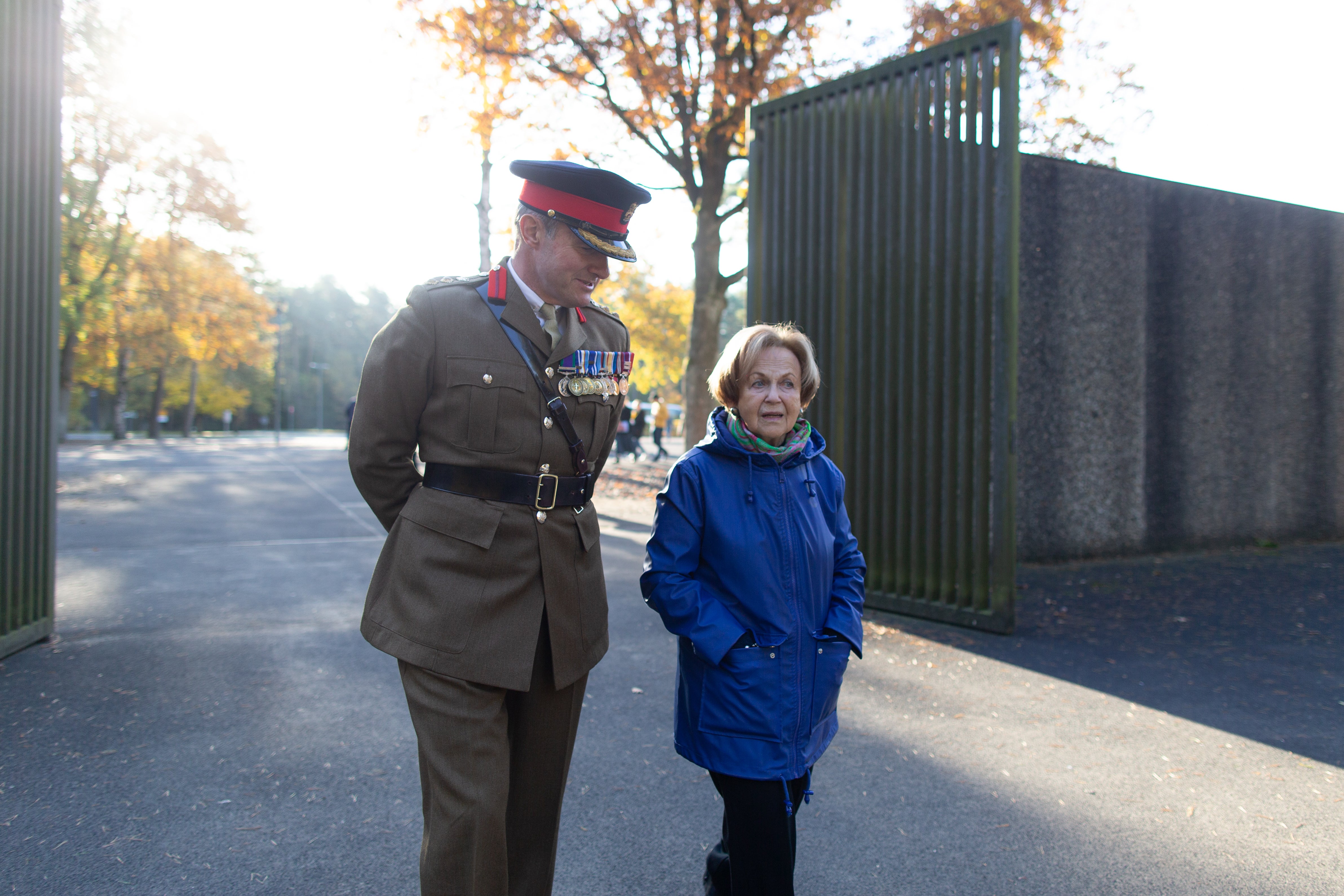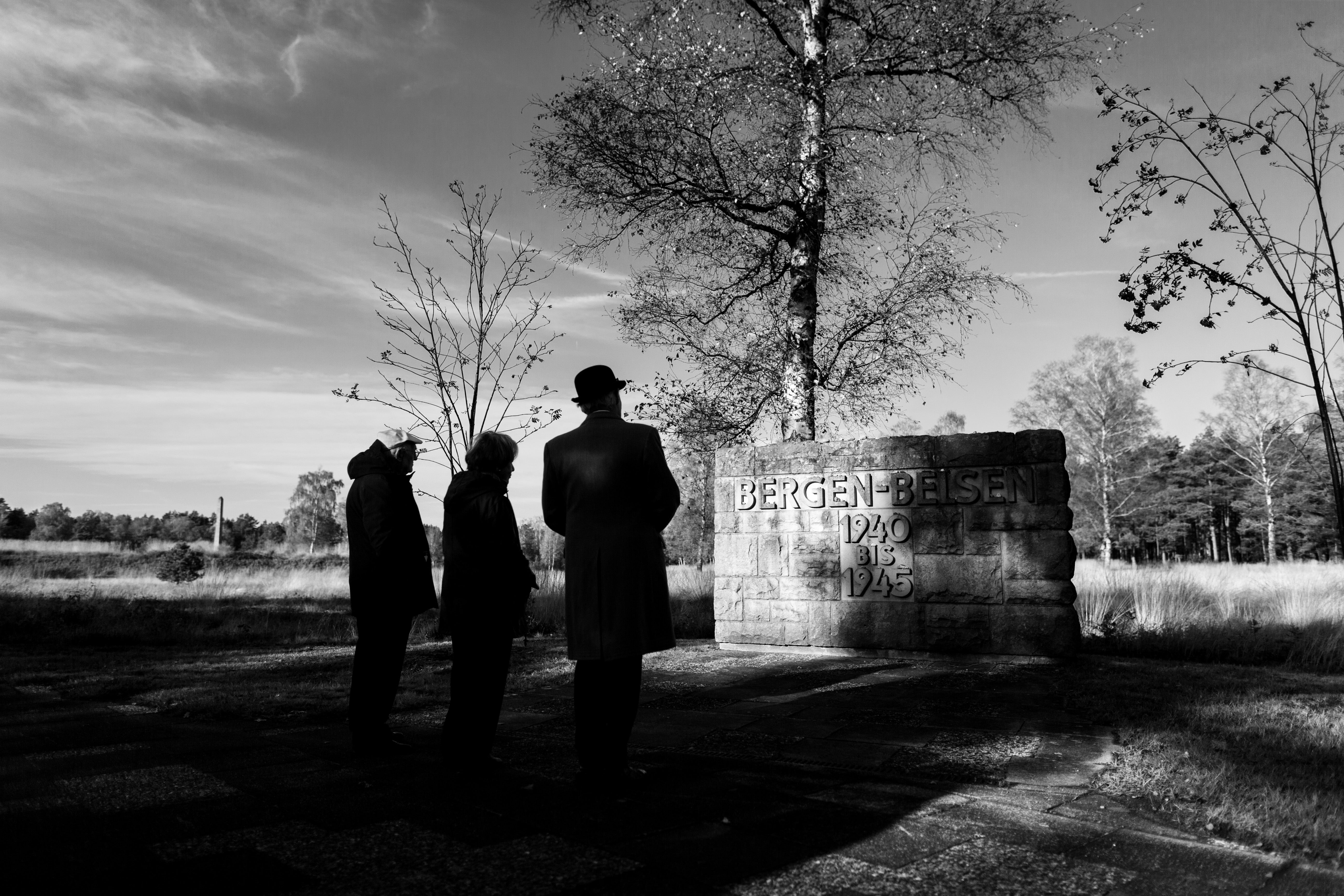
Eve Kugler was just seven years old when Nazi soldiers burst into her home on the night of Kristallnacht, destroying her family’s possessions, desecrating sacred religious books and arresting her father.
She then watched from the window of her apartment as the synagogue her grandfather had helped build went up in flames and her father was led away to be taken to the infamous Buchenwald concentration camp.
Last year, Kugler returned to this apartment block in Halle for the first time since June 1939, when her family was forced to go into hiding as the Nazis escalated the violent persecution of the Jewish population of Germany.
“Going up those stairs and actually being in front of the apartment door, it brought tears to my eyes,” she tells The Independent. “I suddenly realized this was the place I had lived until I was almost eight years old. It was very emotional.”
Kugler, now 91, was in Germany with other Holocaust survivors who were returning to see the places where they had lived, been imprisoned in and escaped from during the Nazi occupation.
This included the Ravensbrück women and children concentration camp where Mala Tribich had been sent in December 1944 aged just 14.

Now 92, Tribich recalls the violence and brutality at the hands of the SS guards. “They used their whips very freely, I saw people being hit for nothing,” she says.
Tribich also spoke about the terrible cold that “penetrated our bones” when she arrived with other women and children at the concentration camp, having already spent two years as a slave labourer for the Nazis.
“There was no way to warm up,” she says. “The winter in Germany was freezing. People died next to me from cold and hunger. We got half a slice of bread and soup every night in the evening.”
But it was losing her identity that Tribich found hardest to bear, and she describes how the women’s heads were all shaved and they were given the same striped prisoner uniforms to wear.
After a few months at the Ravensbrück camp, many of the women, including Tribich, were loaded onto trucks and transferred to the Bergen-Belsen concentration camp, which she describes as “a horror show”.
“There were corpses everywhere, in piles,” she says. “People walked around like zombies.”

Alfred Garwood, now 80, was a young child of nearly four when the camp was liberated. He recalls how he and the other children played near the dead bodies while imprisoned with his mother.
“We suffered quietly,” he says. “The ones who cried were killed. My friends died next to me.”
Bergen-Belsen was the infamous concentration camp where Anne Frank was imprisoned alongside her sister Margot. Like Anne, Tribich developed typhus, but unlike Anne and Margot she survived the illness and the horrors of Bergen-Belsen to see the camp liberated in 1945.
Although she found the trip to be a deeply emotional and painful experience, Tribich, who has lived in the UK since 1947, feels that it was important to make the journey to Germany in order to remember the people who died during the Holocaust.
“I feel that if we do not mention them, they will be forgotten, as if they never lived,” she says. “As the generations go by, this is the way to make sure the victims are not forgotten, and the memory continues.”
She tells The Independent about her “luck” of narrowly avoiding death so she is a survivor today when so many others were murdered at the hands of the Nazis.
Tribich, who is originally from Piotrkow, Poland, recalls the moment, at 12 or 13 years old, that she was rounded up with a group on other children by Nazi soldiers outside the ghetto where her family lived.
Despite being a shy child, Tribich approached the SS officer in charge and asked to be allowed back to her mother and father. “People outside will never know the amount of courage you needed to do that,” she says.
The soldier allowed Tribich and her cousin to return to the ghetto. She later discovered that the group of children were led away to the forest and shot.
Like Tribich, Kugler says that returning to Germany was a chance to remember the millions who had been murdered in the Holocaust. A few weeks after Kristallnacht, Kugler and her family managed to flee Germany to France, with her father escaping Buchenwald concentration camp thanks to a forged visa.
Kugler and her older sister Ruth were sent to the United States where they stayed with foster families until they were reunited with their parents after the war, but many of her relatives did not survive the Holocaust.
She says that one of the most important moments for her while visiting Germany was to see that her grandfather Markus Kanner is commemorated at the synagogue in Halle.
It stands close to the site where the synagogue he helped found was burnt to the ground in 1938 before he was taken away by the Nazis. After that day, Kugler and her family never heard from Kanner again.
“Because my grandfather was deported, we have no idea where he was buried and there was no record he ever lived and contributed so much to Jewish communities,’ Kugler tells The Independent. “To see his name there in the synagogue verified that he had existed. That was the best part of coming back to Halle.”
In October 2019, this synagogue in Halle was the target of a deadly attack by a white supremacist that left two people dead and nearly became the country’s worst anti-Semitic atrocity since World War II.
Kugler says this served as a reminder to her of how important it is that the lessons of the Holocaust are not forgotten.
“When I heard the news of the attack on the synagogue in Halle, everything came back to me,’ says Kugler. “I could not believe that Jews were being attacked in synagogues again. The world has not learned its lesson and Jews are still unsafe.”
Kugler, Tribich and Garwood were joined on their trip to Germany, which was organised by March of the Living, by representatives of the British Army, including the unit that liberated the Bergen-Belsen camp in April 1945.
When the soldiers arrived at the camp they discovered horrors that were beyond comprehension with thousands of corpses littered around the camp and 60,000 starving and desperately ill prisoners packed together in inhumane conditions.
Colonel Dickie Winchester and Lieutenant Colonel Simon Ledger joined the Holocaust survivors in a ceremony to commemorate the victims. They laid a wreath that simply read: “We did what we could.”







